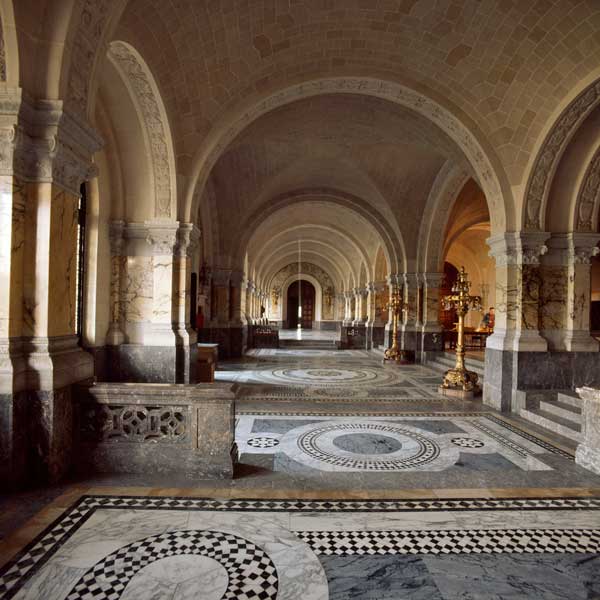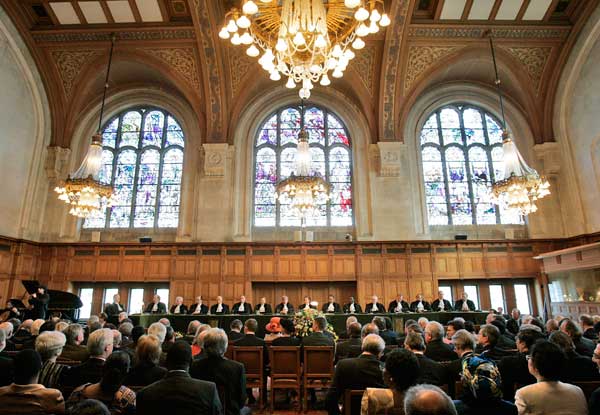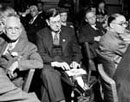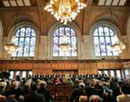|
Statute of the International Court of Justice
San Francisco, 26 June 1945
By Antônio Augusto Cançado
Trindade
Judge of the International Court of Justice Former President of the Inter-American Court of Human Rights Emeritus Professor of International Law of the University of Brasília, Brazil
I. Historical Antecedents and Lessons from the Past
Although the League of Nations had taken the initiative of the creation of the PCIJ, it was not integrated into the League. The PCIJ operated from 15 February 1922 (when it held its inaugural sitting) until 1940. Many treaties and conventions conferred jurisdiction upon the PCIJ. In that period, the PCIJ settled 29 contentious cases and issued 27 advisory opinions. It was only in 1946 that the new ICJ was established,2 with the adoption of its Statute at the San Francisco Conference on 26 June 1945. The ICJ Statute relied upon the Statute of its predecessor, the PCIJ; even so, a process of redrafting was undertaken − with the necessary adjustments in the light of the historical experience3 − first by the United Nations Committee of Jurists, and then by the Fourth Committee of the United Nations Conference on International Organization (UNCIO) in San Francisco in 1945. An important innovation introduced by the ICJ Statute was its structural interrelationship with the United Nations Charter. The ICJ was incorporated into the United Nations, its Statute forming an integral part of the United Nations Charter. Distinctly, in the case of the PCIJ, the relationship between the Court and the then existing procedures of other (arbitral) organs of dispute-settlement was stated in Article 1 of the PCIJ Statute, in the following terms: the PCIJ would be “in addition to the Court of Arbitration organized by the Conventions of The Hague of 1899 and 1907, and to the special Tribunals of Arbitration to which States are always at liberty to submit their disputes for settlement”. By contrast, the ICJ Statute is annexed to the United Nations Charter itself. It sets forth the structure of the Court, its powers and competences, and the applicable law; the ICJ’s interrelationship with the United Nations is enhanced, pursuant to Article 92 of the Charter, which states that:
Thus, while Article 92 of the ICJ Statute makes reference to the PCIJ Statute, the intimate relationship between the ICJ and the United Nations is clearly defined under Article 92 of the Charter, characterizing the ICJ as “the principal judicial organ of the United Nations”. This tight connection is also evidenced by Article 93 of the Charter, which states that all Member States of the United Nations are ipso facto parties to the Statute of the ICJ. Another provision which has a direct bearing on the interrelationship between the ICJ and the United Nations is Article 94 of the Charter, which provides that each Member State of the United Nations “undertakes to comply with the decision of the International Court of Justice in any case to which it is a party”. These provisions show that, although the ICJ Statute relied on the PCIJ Statute, it also included innovations, in particular as to the interrelationship between the World Court and the United Nations. With the establishment of the ICJ, much was learned from the experience of the PCIJ, and also from its jurisprudence (infra). In April 1946, with the formal dissolution of the PCIJ, the ICJ came into operation. II. Basis of International Jurisdiction The ICJ Statute secures (Article 9), in the composition of the Court, the due representation of the main juridical systems of the world. The ICJ is composed of 15 judges, elected by the United Nations General Assembly and Security Council. There cannot be two judges of the nationality of the same State. In case there is not, amongst the members (elected judges) of the ICJ, a judge of the nationality of a State as contending party, this State can designate a judge ad hoc, of its choice, for the concrete case, once his or her name is approved by the members of the ICJ. The ICJ, throughout its history, has defined its role in the judicial settlement of international disputes, as the judicial organ of the legal order of the international community as a whole, and not only of the contending parties appearing before it.4 In recent years, the ICJ has been called to pronounce upon the most diverse areas of international law, in cases originating from all the regions of the world. They have been submitted to the ICJ either through Applications Instituting Proceedings5 – on the basis of the optional clause, or else of compromissory clauses – or through Special Agreements/compromise.6 It is for the ICJ itself to decide on questions regarding its jurisdiction: according to Article 36, paragraph 6, in the event of a dispute as to whether the ICJ has jurisdiction in a given case, the matter shall be settled by a decision of the Court. A way whereby the ICJ may have jurisdiction is through the declarations recognizing as compulsory the jurisdiction of the Court (optional clause), which take the form of a declaration of its acceptance, deposited by the State concerned with the United Nations Secretary-General. These declarations are provided for in Article 36, paragraph 2, of the Statute.7 At present (beginning of 2014), there are 70 declarations deposited with the United Nations Secretary-General.8 Out of the 70 declarations, 6 of them were made under the Statute of the PCIJ, which have not lapsed or been withdrawn, and thus remain valid, under Article 36, paragraph 5, in relation to the ICJ. As the ICJ lacks (automatic) compulsory jurisdiction, its Statute provides for the optional clause (Article 36(2)) of acceptance of the Court’s jurisdiction (supra), as well as for compromissory clauses (Article 36(1)). As to the latter, Article 36, paragraph 1, provides the basis for the Court’s contentious jurisdiction on “all cases which the parties refer to it and all matters specially provided for in the Charter of the United Nations or in treaties and conventions in force”. The last basis of jurisdiction is thus found in clauses of treaties and conventions that refer to the ICJ for the adjudication of disputes9 (compromissory clauses).10 Much has been written on the basis of jurisdiction of the ICJ. In my extensive Dissenting Opinion (paras. 1-214) in the ICJ’s judgment (of 1 April 2011) in the case of the Application of the Convention on the Elimination of All Forms of Racial Discrimination (CERD), I deemed it fit to point out the difficulties experienced in the long path towards compulsory jurisdiction.11 Throughout the last decades, advances could here have been much greater if State practice would not have undermined the original purpose which inspired the creation of the mechanism of the optional clause of compulsory jurisdiction (of the PCIJ and the ICJ), that is, the submission of political interests to Law, rather than the acceptance of compulsory jurisdiction in the way one freely wishes (with restrictions). Only in this way would one, as originally envisaged, achieve greater development in the realization of justice at the international level on the basis of compulsory jurisdiction.
These hopes have grown in recent years, with the increasing recourse to compromissory clauses as basis of jurisdiction.15 This development has been seen as a reassuring one, in the sense of diminishing the probability of procedural incidents, such as the recourse to exceptions or objections of admissibility of applications instituting proceedings, or of the jurisdiction itself of the ICJ. Around 128 multilateral conventions and 166 bilateral treaties contain clauses providing for the recourse to the ICJ for the settlement of disputes on their interpretation or application – the so-called compromissory clauses. In any case, the ICJ retains at least the power and duty to address motu proprio the issue of jurisdiction.16 The time has come to overcome definitively the regrettable lack of automatism of the international jurisdiction, which, despite all difficulties, has become reality in respect of some international tribunals.17 In sum, there is a diversity of legal bases to submit a contentious case to the knowledge and decision of the ICJ. There are examples, in recent years, of recourse to each of them, fostering the judicial settlement of international disputes. The procedure before the ICJ comprises two phases – the written phase followed by the oral one – conducted in the two official languages of the ICJ (English and French). Since the lodging of the first case with the ICJ (the Corfu Channel case) in May 1947 until now (beginning of 2014), 157 cases have entered the Court’s general list. Contentious cases have, in recent years, concerned States from all continents (the Americas, Europe, Africa, Asia and Oceania), highlighting the role of the ICJ as the principal judicial organ of the whole system of the United Nations. III. Sources of International Law
General principles of law, enlisted inter alia in Article 38 of the ICJ Statute, encompass those found in all national legal systems (thus ineluctably linked with the very foundations of Law), and likewise the general principles of international law itself. Such principles inform and conform the norms and rules of international law, being – in my own conception – a manifestation of the universal juridical conscience, the ultimate material source of all Law. In the jus gentium in evolution, basic considerations of humanity play a role of the utmost importance. Reaffirmed time and time again, those principles give expression to the idea of an objective justice, paving the way to the application of the universal international law, the new jus gentium of our times.19 IV. Contentious Cases: Shortcomings of the Strict Inter-State Dimension From the start, the jurisdiction of the ICJ (and of its predecessor, the PCIJ) has been faced with a limitation ratione personae: only States may submit contentious cases to it (Article 34(1) of its Statute). At the time of the drafting and adoption, in 1920, of the PCIJ Statute, a choice was made for a strictly inter-State dimension for its exercise of the international judicial function in contentious matters. Yet, as I have pointed out in my Separate Opinion (paras. 76-81) in the ICJ’s Advisory Opinion (of 1 February 2012) on a Judgment of the ILO Administrative Tribunal upon a Complaint Filed against the IFAD, the fact that neither the Advisory Committee of Jurists in 1920, nor the draftsmen of the ICJ Statute in 1945, found that the time was ripe to grant access to the PCIJ, and later to the ICJ, to subjects of rights other than States (such as individuals), did not mean that a definitive answer had been found to the question at issue. It should not pass unnoticed that the very advent of permanent international jurisdiction at the beginning of the twentieth century, before the creation of the PCIJ, was not marked by a purely inter-State outlook of the international contentieux.20
In considerations developed in the examination of such matters, the PCIJ went well beyond the inter-State dimension, taking into account the position of individuals themselves (as in, inter alia, the Advisory Opinions on German Settlers in Poland, 1923; the Jurisdiction of the Courts of Danzig, 1928; the Greco-Bulgarian “Communities”, 1930; Access to German Minority Schools in Upper Silesia, 1931; Treatment of Polish Nationals in Danzig, 1932; Minority Schools in Albania, 1935).22 Ever since, the artificiality of that dimension became noticeable and acknowledged, already at an early stage of the case-law of the PCIJ. The option in 1920 (endorsed in 1945) for an inter-State mechanism for judicial settlement of contentious cases, was made, as I have recalled,
The dogmatic position of the PCIJ Statute passed on to the ICJ Statute. Once again, the exclusively inter-State character of the contentieux before the ICJ has not appeared satisfactory at all. At least in some cases (cf. infra), pertaining to the condition of individuals, the presence of these individuals (or of their legal representatives), in order to submit, themselves, their positions, would have enriched the proceedings and facilitated the work of the Court. The artificiality of the exclusively inter-State outlook has been criticised, time and time again, in expert writing, which has recalled that “nowadays a very considerable part of international law” (e.g., law-making treaties) “directly affects individuals”, and the effect of Article 34, paragraph 1, of the ICJ Statute has been “to insulate” the Court, by remaining attached to “notions about international law structure of the 1920s”.24 For example, the strictly inter-State mechanism appeared manifestly inadequate in the handling of the case of the Application of the Convention of 1902 Governing the Guardianship of Infants (1958).25 There has also been sharp criticism of the Court’s handling of the East Timor case (1995), where the East Timorese people had no locus standi to request intervention in the proceedings, not even to present an amicus curiae, although the crucial point under consideration was that of sovereignty over their territory. Worse still, the interests of a third State (which had not even accepted the Court’s jurisdiction) were taken for granted for the purpose of protection, and promptly safeguarded by the Court, at no cost to itself, by means of the application of the so-called Monetary Gold “principle”.26 The aforementioned examples are far from being the only ones; they in fact abound in the history of the ICJ. In respect of situations concerning individuals or groups of individuals, reference can further be made, for example, to the Nottebohm case (1955) pertaining to double nationality; the Trial of Pakistani Prisoners of War case (1973), the Hostages (U.S. Diplomatic and Consular Staff) in Teheran case (1980); the Frontier Dispute between Burkina Faso and Mali case (1986); the Application of the Convention against Genocide case (1996 and 2007); and the triad of cases concerning consular assistance, namely, the Breard case (Paraguay versus United States of America, 1998), the LaGrand case (Germany versus United States of America, 2001), the Avena and Others case (Mexico versus United States of America, 2004). In respect of those cases, one cannot fail to reckon that one of their predominant elements was precisely the concrete situation of the individuals directly affected, and not merely abstract issues of exclusive interest of the litigating States in their relations inter se. Moreover, one may further recall that, in the case of Armed Activities in the Territory of the Congo (Democratic Republic of the Congo versus Uganda, 2005), the ICJ was concerned with grave violations of human rights and of International Humanitarian Law; and in the case concerning the Land and Maritime Boundary between Cameroon and Nigeria (1996) the Court was likewise concerned with the victims of armed clashes. More recently, examples wherein the Court’s concerns have had to go beyond the inter-State outlook have further increased in frequency. They include, for example, the case on Questions Relating to the Obligation to Prosecute or Extradite (2009-2013) pertaining to the principle of universal jurisdiction under the Convention against Torture and Other Cruel, Inhuman or Degrading Treatment or Punishment, the case of A.S. Diallo (2010) on the detention and expulsion of a foreigner, the case of the Jurisdictional Immunities of the State (2010-2012), the case of the Application of the International Convention on the Elimination of All Forms of Racial Discrimination (2011), and the case of the Temple of Preah Vihear (provisional measures, 2011). The same can be said of the two last advisory opinions of the Court, on the Declaration of Independence of Kosovo (2010), and on a Judgment of the ILO Administrative Tribunal upon a Complaint Filed against the IFAD (2012), respectively. The artificiality of the exclusively inter-State outlook has thus been made often manifest, and increasingly so; that outlook rests on a longstanding dogma of the past. Those more recent contentious cases, and requests for advisory opinions, lodged with the Court, have asked it, by reason of their subject-matter, to overcome that outlook.
V. Other Jurisdictional and Procedural Issues in Contentious Cases 1. Intervention Another issue to be singled out, also in respect of the exercise of jurisdiction by the ICJ in contentious cases, pertains to the intervention of States in cases before the Court. Articles 62 and 63 of the Statute provide the framework for such interventions of States in the legal process. While both provisions concern those interventions of States, there are differences between the two. Under Article 62, there is a requirement that the requesting State must consider that it “has an interest of a legal nature which may be affected by the decision in the case”. Thus, the State willing to intervene in a contentious case must submit a request for permission to intervene upon which the Court decides. There have been few applications for permission to intervene under Article 62 before the ICJ, and only one before the PCIJ.28 Lately, the Court has dealt with almost subsequent applications for permission to intervene in the case concerning Territorial and Maritime Dispute (Nicaragua versus Colombia, 2011)29 and in the case concerning Jurisdictional Immunities of the State (Germany versus Italy: Greece intervening, 2010-2012).30 In the latter case, for the first time in its history, the ICJ, in its order of 4 July 2011, granted the faculty of intervention to a third intervenor (as non-party, Greece), thus transcending the traditional tendency to a bilateralization of the contentieux, proper to the arbitral experience of the past. As to intervention under Article 63 of the Statute,31 in contrast with the intervention under Article 62, it happens as of right (and the ICJ should thus have no discretion in deciding whether or not to allow intervention, if the criteria are met), whenever the construction of a Convention (to which the intervening State is also a Party) is at issue. All States that have been notified have “the right to intervene in the proceedings”, and, if a State does so, the construction given by the judgment will also be binding upon it. Unlike interventions under Article 62, the intervening party does not need to have an “interest of a legal nature” in the proceedings. Intervention under Article 63 occurs in contentious proceedings through the filing of a “declaration of intervention”. There have been very few declarations of intervention under Article 63 of the Statute. Recently, in the case concerning Whaling in the Antarctic (Australia versus Japan: New Zealand intervening), New Zealand made a declaration of intervention (concerning the construction of article VIII of the 1946 International Convention for the Regulation of Whaling at issue) and thus intervened in the case.32 2. Interpretation and Revision At this juncture, another relevant issue relating to the Court’s jurisdiction lies in the possibilities of reopening a case either for interpretation (as in the aforementioned case of the Temple of Preah Vihear), or for revision. Interpretation and revision are provided for in Articles 60 and 61 of the ICJ Statute. According to Article 60, in case of a disagreement as to the meaning and scope of a judgment, the Parties may request the Court to construe it. The request for interpretation may be submitted either by application of one or more of the Parties or by a special agreement.33 Before the Court can entertain a request for interpretation, there must be a dispute (“une contestation”) as to the meaning and scope of the judgment. The PCIJ, in its landmark judgment on the matter, in the Chorzów Factory case (1927), stated that, under that provision, “it should be sufficient if the two Governments have in fact shown themselves as holding opposite views in regard to the meaning or scope of a judgment of the Court”.34 The interpretation to be rendered by the Court must be kept within the confines of the judgment which is the object of the requested interpretation.35 Another way whereby the Court may be seized of a reopened case is through a request for revision of a judgment, as provided in Article 61 of the Court’s Statute. An application for revision of a judgment may be filed only when it is based on the discovery of a fact, taken as decisive, that, when the judgment was delivered, was unknown to the Court and also to the party claiming revision, and such lack of knowledge was not due to negligence. As distinct from requests for interpretation, there is a time-limit for filing the request, that is, the application for revision36 must be made within six months of discovering the new fact.37 It is clear that the notion of revision of judgments may encroach on the concept of res judicata, and thus the terms of Article 61 of the Statute make it clear that revision procedures are of an exceptional nature, especially in the light of the principle stated in Article 60 that the judgments of the Court are final and without appeal. The revision procedure has been used in very limited instances throughout the history of the ICJ: there have been only three judgments addressing revision, and all found the respective applications inadmissible.38 VI. Provisional Measures of Protection In situations of gravity and urgency, the ICJ can indicate or order provisional measures of protection, pursuant to Article 41 of its Statute, so as to prevent or avoid irreparable harm. Such provisional measures, thus endowed with a preventive dimension, have a binding character. Along the last decades, in its orders of provisional measures the ICJ has in fact to a large extent based its reasoning either on the need to avoid or prevent an imminent and irreparable harm to the rights of the contending parties (including the rights of the human person), or, more comprehensively, on the need to avoid or prevent the aggravation of the situation which would be bound to affect or harm irreparably the rights of the parties. Yet, in my understanding, the rationale of such orders of the ICJ does not need to limit or exhaust itself in a reasoning of the kind. In the case concerning Questions Relating to the Obligation to Prosecute or to Extradite (Belgium versus Senegal, order of 28 May 2009) − where the Court decided not to indicate provisional measures − I warned, in my dissenting opinion (para. 97), that the basic right at issue pertained to the realization of justice, and the fact that the binding character of provisional measures of protection is nowadays beyond question, on the basis of the res interpretata of the ICJ itself, does not mean that we have reached a culminating point in the evolution of the ICJ case-law on this matter. In its order of 18 July 2011, in the case (reopened after half a century) of the Temple of Preah Vihear (Cambodia versus Thailand), the ICJ, in the provisional measures of protection it ordered, determined, for the first time in its history, the creation of a demilitarized zone in the region, which from then onwards put an end to the armed hostilities therein. The determination of urgency and the probability of irreparable damage are exercises to which the ICJ is nowadays used to; yet, although the identification of the legal nature and the material content of the right(s) to be preserved seem not to present great difficulties, the same cannot be said of the consideration of the legal effects and consequences of the right(s) at issue. In sum, the construction of the whole legal regime, proper for provisional measures of protection, still lies ahead of us. VII. The Expanded Advisory Jurisdiction It was with the PCIJ that, for the first time, an international tribunal was attributed the advisory function − surrounded as it was by much discussion. Originally conceived to assist the Assembly and the Council of the League of Nations, the PCIJ, making good use of it, ended up assisting not only those organs, but States as well: among the 27 advisory opinions it delivered, 17 of them addressed then existing aspects of disputes between States. It thus contributed to the avoidance of full-blown contentious proceedings, and exercised a preventive function, to the benefit of judicial settlement itself of international disputes.39 The advisory function, as exercised by the PCIJ, thus contributed also to the progressive development of international law. The same can be said of the exercise of the advisory function by the ICJ (pursuant to Article 65 of its Statute and Article 96 of the United Nations Charter). Upon the filing of a request for an advisory opinion, the Court makes up a list of States and international organizations which could furnish information on the question before the Court. The ICJ has discretion to decide whether to give a requested advisory opinion, and it has regularly issued the requested opinions. Ever since the advent of the ICJ, the advisory jurisdiction has kept on expanding. While the PCIJ Statute enabled only the League Council and Assembly to request advisory opinions, the ICJ Statute has enabled the United Nations main organs (General Assembly, Security Council and Economic and Social Council) and specialized agencies (such as ILO, FAO, UNESCO, ICAO, IMO, WMO, WHO, WIPO, UNIDO, TU, IBRD, IMF, IFC, IFAD) to do so. In effect, the exercise of the advisory function by the ICJ is another aspect that highlights the interconnectedness between the United Nations and the Court itself. Such interrelationship is demonstrated, at first, by the combined reading of Article 65 of the ICJ Statute and Article 96 of the United Nations Charter. Secondly, United Nations main organs, such as the General Assembly and the Security Council, are entitled to request an advisory opinion from the ICJ on any legal question.40 Other United Nations organs or specialized agencies may request an advisory opinion, upon authorization by the General Assembly, on legal questions falling within the scope of their operation or activities (Article 96 of the United Nations Charter).
VIII. The ICJ in the Era of International Tribunals The gradual realization − that we witness, and have the privilege to contribute to, nowadays − of the old ideal of justice at the international level42 has been revitalizing itself, in recent years, with the reassuring creation and operation of the multiple contemporary international tribunals. This is a theme which has definitively assumed a prominent place on the international agenda of this second decade of the twenty-first century. It was necessary to wait for some decades for the current developments in the realization of international justice to take place, not without difficulties,43 now enriching and enhancing contemporary international law. International legal personality and capacity (not only of States, but also of international organizations and individuals) have indeed been enhanced, and international jurisdiction and responsibility have likewise expanded. The ICJ, together with other international tribunals, assert and confirm nowadays the aptitude of contemporary international law to resolve the most distinct types of international controversies, at inter-State and intra-State levels. It should not pass unnoticed that the cases that reach the international tribunals constitute a minimal portion of the multiple injustices and abuses perpetrated daily against human beings and peoples all over the world. This is what should be of concern to international legal doctrine, and not false problems of delimitation of competences or inter-institutional competition. The coordination and dialogue among contemporary international tribunals are quite important, as their respective works are complementary and they have the common mission of imparting justice. Nowadays, the international community fortunately counts on a wide range of international tribunals, adjudicating cases that take place not only at the inter-State level, but also at the intra-State level. This is reassuring, and was foreseen in the United Nations Charter itself, which provides, in Article 95, that United Nations Member States may entrust the settlement of their differences “to other tribunals by virtue of agreements already in existence or which may be concluded in the future”. Such reassuring coexistence of international tribunals nowadays invites us to approach their work from the correct perspective of the justiciables themselves,44 and brings us closer to their common mission of securing the realization of international justice, either at the inter-State or at the intra-State level.45Access to international justice has reassuringly been enlarged. From the standpoint of the needs of protection of the justiciables, each international tribunal has its importance, in a wider framework encompassing the most distinct situations to be adjudicated, in each respective domain of operation.46 In sum, the present era of international tribunals has brought about remarkable advances, and the expansion of international jurisdiction has been accompanied by the considerable increase in the number of the justiciables, granted access to justice, in distinct domains of international law, and in the most diverse situations, including in circumstances of the utmost adversity, and even defenselessness. Yet, there still remains a long way to go. IX. Concluding Observations Last but not least, the issue of compliance with judgments and decisions of the ICJ and other contemporary international tribunals is a legitimate concern of all of them. The issue encompasses two complementary aspects: measures of domestic law for the execution of international sentences, and mechanisms of monitoring and follow-up, for the supervision of compliance with those judgments and decisions. As to the former, very few States have so far taken concrete initiatives to secure, on a permanent basis, the faithful execution of international judgments concerning them. As to the latter, each international tribunal counts on a mechanism of its own; yet, all of them are susceptible of improvement. The ICJ itself can address this issue during the presentation of itsannual reportsto the United Nations General Assembly as well as the visit of the President to its Sixth Committee and the Security Council. That compliance ought to be integral, rather than partial or selective. This is a position of principle, in relation to an issue which pertains to the international ordre public, and to the rule of law (préeminence du droit) at international and national levels. There is still much to be done in this respect, to secure the continuing advances in the quest for the realization of international justice. With the continuing operation of the ICJ together with other international tribunals, two basic distinct conceptions of the exercise of the international judicial function have gradually emerged: one − a strict one − whereby the tribunal has to limit itself to settle the dispute at issue and to handle its resolution of it to the contending parties (a form of transactional justice), addressing only what the parties have put before it; the other, a larger one − the one I sustain − whereby the tribunal has to go beyond that, and say what the Law is (juris dictio), thus contributing to the settlement of other like situations as well, and to the progressive development of international law. In the interpretation itself − or even in the search − of the applicable law, there is space for judicial creativity; each international tribunal is free to find the applicable law, independently of the arguments of the contending parties47 (juria novit curia). It should not pass unnoticed that there has lately been a wide thematic diversity in cases lodged with the ICJ, as never before. Among very recent cases resolved by the ICJ, there are some that have raised questions of the utmost relevance, pertaining to International Humanitarian Law, to the International Law of Human Rights, to International Environmental Law, among other themes.48 The outlook of the ICJ could hardly be a strict one (proper for transactional justice): in my understanding, in solving such issues, the ICJ is bound to say what the Law is (juris dictio). Furthermore, there are circumstances when the judgments of international tribunals may have repercussions beyond the States parties to a case. Such repercussions tend to occur when the judgments succeed to give expression to the idea of an objective justice. In this way, they contribute to the evolution of international law itself, and to the rule of law at the national and international levels in democratic societies. The more international tribunals devote themselves to explaining clearly the foundations of their decisions, the greater their contribution to justice and peace is bound to be.49 In my conception, in judgments of international tribunals (also at the regional level), the motifs and the dispositif go together: one cannot separate the decision itself from its foundations, from the reasoning which upholds it. Reason and persuasion permeate the operation of justice, and this goes back to the historical origins of its conception. The ICJ has an important role in the peaceful settlement of international disputes and the progressive development of international law.50 A unique feature of the ICJ Statute is the Court’s role as the principal judicial organ of the United Nations and its close relationship with the Organization (cf. supra). While much has been developed in the jurisprudence of the Court to date, there is still some room for improvement. The ICJ needs to remain attentive to the evolution of international law itself, which is not static, is not the same as when the ICJ was first established. While the Court, in contentious cases, remains open only to States, its judgments and decisions, and advisory opinions as well, have wide implications for other subjects of international law (international organizations, individuals and groups of individuals). In this regard, a continuing expansion of the advisory function of the Court and a broader conception of its jurisdiction in contentious matters can be envisaged, as the ICJ has a prominent role for the development of international law at the service of the international community as a whole. This Introductory Note was written in September 2014.
Related Material
A. Legal Instruments Treaty of Peace between the Allied and Associated Powers and Germany, Part I: Covenant of the League of Nations, Versailles, 28 June 1919, League of Nations, Treaty Series, vol. 1, p. 403 (registered but not reproduced), reproduced in League of Nations, Official Journal, 1st year, No. 1, February 1920, p. 3. Statute of the Permanent Court of International Justice, Geneva, 13 December 1920, League of Nations, Treaty Series, vol. 6, p. 390. Charter of the United Nations, San Francisco, 26 June 1945. B. Jurisprudence Permanent Court of International Justice Permanent Court of International Justice, German Settlers in Poland, Advisory Opinion of 10 September 1923, P.C.I.J., Series B, No. 6. Permanent Court of International Justice, Interpretation of Judgments Nos. 7 and 8 (Factory at Chorzów), Judgment of 16 December 1927, P.C.I.J., Series A, No. 13. Permanent Court of International Justice, Jurisdiction of the Courts of Danzig, Advisory Opinion of 3 March 1928, P.C.I.J., Series B, No. 15. Permanent Court of International Justice, Greco-Bulgarian “Communities”, Advisory Opinion of 31 July 1930, P.C.I.J, Series B, No. 17. Permanent Court of International Justice, Access to German Minority Schools in Upper Silesia, Advisory Opinion of 15 May 1931, P.C.I.J, Series A/B, No. 40. Permanent Court of International Justice, Treatment of Polish Nationals and Other Persons of Polish Origin or Speech in the Danzig Territory, Advisory Opinion of 4 February 1932, P.C.I.J, Series A/B, No. 44. Permanent Court of International Justice, Minority Schools in Albania, Advisory Opinion of 6 April 1935, P.C.I.J, Series A/B, No. 64. See also, Summaries of Judgments, Advisory Opinions and Orders of the Permanent Court of International Justice. International Court of Justice International Court of Justice, Nottebohm Case (second phase), Judgment of April 6th, 1955, I.C.J. Reports 1955, p. 4. International Court of Justice, Case concerning the Application of the Convention of 1902 governing the Guardianship of Infants (Netherlands v. Sweden), Judgment of November 28th, 1958, I.C.J. Reports 1958, p. 55. International Court of Justice, Trial of Pakistani Prisoners of War, Interim Protection, Orders of 13 July, 29 September and 15 December 1973, I.C.J. Reports 1973, p. 328, 344 and 347. International Court of Justice, United States Diplomatic and Consular Staff in Tehran, Judgment, I.C.J. Reports 1980, p. 3. International Court of Justice, Application for Revision and Interpretation of the Judgment of 24 February 1982 in the Case concerning the Continental Shelf (Tunisia/Libyan Arab Jamahiriya) (Tunisia v. Libyan Arab Jamahiriya), Judgment, I.C.J. Reports 1985, p. 192. International Court of Justice, Frontier Dispute, Judgment, I.C.J. Reports 1986, p. 554. International Court of Justice, East Timor (Portugal v. Australia), Judgment, I.C.J. Reports 1995, p. 90. International Court of Justice, Land and Maritime Boundary between Cameroon and Nigeria, Provisional Measures, Order of 15 March 1996, I.C.J. Reports 1996, p. 13. International Court of Justice, Application of the Convention on the Prevention and Punishment of the Crime of Genocide, Preliminary Objections, Judgment, I.C.J. Reports 1996, p. 595. International Court of Justice, Vienna Convention on Consular Relations (Paraguay v. United States of America), Provisional Measures, Order of 9 April 1998, I.C.J. Reports 1998, p. 248. International Court of Justice, LaGrand (Germany v. United States of America), Judgment, I.C.J. Reports 2001, p. 466. International Court of Justice, Application for Revision of the Judgment of 11 July 1996 in the case concerning the Application of the Convention for the Prevention and Punishment of the Crimes of Genocide (Bosnia Herzegovina v. Yugoslavia), Preliminary Objections (Yugoslavia v. Bosnia and Herzegovina), Judgment, I.C.J. Reports 2003, p. 7. International Court of Justice, Application for Revision of the Judgment of 11 September 1992 in the Case concerning the Land, Island and Maritime Frontier Dispute (El Salvador/Honduras: Nicaragua intervening) (El Salvador v. Honduras), Judgment, I.C.J. Reports 2003, p. 392. International Court of Justice, Avena and Other Mexican Nationals (Mexico v. United States of America), Judgment, I.C.J. Reports 2004, p. 12. International Court of Justice, Application of the Convention on the Prevention and Punishment of the Crime of Genocide (Bosnia and Herzegovina v. Serbia and Montenegro), Judgment, I.C.J. Reports 2007, p. 43. International Court of Justice, Questions relating to the Obligation to Prosecute or Extradite (Belgium v. Senegal), Provisional Measures, Order of 28 May 2009, I.C.J. Reports 2009, p. 139. International Court of Justice, Jurisdictional Immunities of the State (Germany v. Italy), Counter-Claim, Order of 6 July 2010, I.C.J. Reports 2010, p. 310. International Court of Justice, Accordance with International Law of the Unilateral Declaration of Independence in Respect of Kosovo, Advisory Opinion, I.C.J. Reports 2010, p. 403. International Court of Justice, Ahmadou Sadio Diallo (Republic of Guinea v. Democratic Republic of the Congo), Merits, Judgment, I.C.J. Reports 2010, p. 639. International Court of Justice, Application of the International Convention on the Elimination of All Forms of Racial Discrimination (Georgia v. Russian Federation), Preliminary Objections, Judgment, I.C.J. Reports 2011, p. 70, and Dissenting opinion of Judge Cançado Trindade. International Court of Justice, Jurisdictional Immunities of the State (Germany v. Italy), Application for Permission to Intervene, Order of 4 July 2011, I.C.J. Reports 2011, p. 494, and Separate opinion of Judge Cançado Trindade. International Court of Justice, Request for Interpretation of the Judgment of 15 June 1962 in the Case concerning the Temple of Preah Vihear (Cambodia v. Thailand) (Cambodia v. Thailand), Provisional Measures, Order of 18 July 2011, I.C.J. Reports 2011, p. 537. International Court of Justice, Judgment No. 2867 of the Administrative Tribunal of the International Labour Organization upon a Complaint Filed against the International Fund for Agricultural Development, Advisory Opinion, I.C.J. Reports 2012, p. 10. International Court of Justice, Jurisdictional Immunities of the State (Germany v. Italy: Greece intervening), Judgment, I.C.J. Reports 2012, p. 99. International Court of Justice, Questions relating to the Obligation to Prosecute or Extradite (Belgium v. Senegal), Judgment, I.C.J. Reports 2012, p. 422. International Court of Justice, Whaling in the Antarctic (Australia v. Japan), Declaration of Intervention of New Zealand, Order of 06 February 2013, and Separate opinion of Judge Cançado Trindade. International Court of Justice, Request for Interpretation of the Judgment of 15 June1962 in the case concerning the Temple of Preah Vihear (Cambodia v. Thailand) (Cambodia v. Thailand), Judgment of 11 November 2013. See also, Summaries of Judgments, Advisory Opinions and Orders of the International Court of Justice. C. Documents International Court of Justice, Rules of Court, 14 April 1978. D. Doctrine G. Abi-Saab, “The International Court as a World Court”, in Fifty Years of the International Court of Justice - Essays in Honour of R. Jennings (eds. V. Lowe and M. Fitzmaurice), Cambridge, CUP, 1996, p. 7. J. A. Allain, A Century of International Adjudication: The Rule of Law and Its Limits, T.M.C. Asser Press, The Hague, 2000. R.P. Anand, Compulsory Jurisdiction of the International Court of Justice, Asia Publishing House, New Delhi/Bombay, 1961. R.P. Anand, “Enhancing the Acceptability of Compulsory Procedures of International Dispute Settlement”, Max Planck Yearbook of United Nations Law, vol. 5, 2001, pp. 1-20. J. Beauté, Le droit de pétition dans les territoires sous tutelle, LGDJ, Paris, 1962. C. Brölmann, “The PCIJ and International Rights of Groups and Individuals”, in C.J. Tams, M. Fitzmaurice and P. Merkouris (eds.), Legacies of the Permanent Court of International Justice, Nijhoff, Leiden, 2013, pp. 123-143. L. Caflisch, “Cent ans de règlement pacifique des différends interétatiques”, Recueil des Cours de l´Académie de Droit International de La Haye, vol. 288 (2001), pp. 365-449. A.A. Cançado Trindade, “Exhaustion of Local Remedies in International Law Experiments Granting Procedural Status to Individuals in the First Half of the Twentieth Century”, Netherlands International Law Review, vol. 24, 1977, pp. 373-392. A.A. Cançado Trindade, “La jurisprudence de la Cour Internationale de Justice sur les droits intangibles / The Case-Law of the International Court of Justice on Non-Derogable Rights”, in Droits intangibles et états d'exception / Non-Derogable Rights and States of Emergency (eds. D. Prémont, C. Stenersen and I. Oseredczuk), Bruylant, Bruxelles, 1996, pp. 69 et seq.. A.A. Cançado Trindade, A Humanização do Direito Internacional, Edit. Del Rey, Belo Horizonte/Brazil, 2006. A.A. Cançado Trindade, Évolution du Droit international au droit des gens - L'accès des particuliers à la justice internationale: le regard d'un juge, Pédone, Paris, 2008. A.A. Cançado Trindade, Évolution du Droit international au droit des gens - L'accès des particuliers à la justice internationale: le regard d'un juge, Pédone, Paris, 2008, pp. 1-187. A.A. Cançado Trindade, “Towards Compulsory Jurisdiction: Contemporary International Tribunals and Developments in the International Rule of Law - Part I”, inXXXVII Curso de Derecho Internacional Organizado por el Comité Jurídico Interamericano - 2010, OAS General Secretariat, Washington D.C., 2011, pp. 233-259. A.A. Cançado Trindade, The Access of Individuals to International Justice, Oxford University Press, Oxford, 2011. A.A. Cançado Trindade, “Towards Compulsory Jurisdiction: Contemporary International Tribunals and Developments in the International Rule of Law - Part II”, in XXXVIII Curso de Derecho Internacional Organizado por el Comité Jurídico Interamericano - 2011, OAS General Secretariat, Washington D.C., 2012, pp. 285-366. A.A. Cançado Trindade, “Contemporary International Tribunals: Their Continuing Jurisprudential Cross-Fertilization, with Special Attention to the International Safeguard of Human Rights”, in The Global Community - Yearbook of International Law and Jurisprudence (2012) vol. I, p. 188. A.A. Cançado Trindade, “A Century of International Justice and Prospects for the Future”, in A.A. Cançado Trindade and Dean Spielmann, A Century of International Justice and Prospects for the Future / Rétrospective d´un siècle de justice internationale et perspectives d´avenir, Oisterwijk, Wolf Legal Publs., 2013, pp. 1-28, esp. pp. 13-16. A.A. Cançado Trindade, Os Tribunais Internacionais Contemporâneos, FUNAG, Brasília, 2013. A.A. Cançado Trindade, Los Tribunales Internacionales Contemporáneos y la Humanización del Derecho Internacional, Ed. Ad-Hoc, Buenos Aires, 2013. A.A. Cançado Trindade, International Law for Humankind - Towards a New Jus Gentium, 2nd rev. ed., Nijhoff, Leiden/The Hague, 2013. M. Cappelletti, Juízes Legisladores?, S.A. Fabris Ed., Porto Alegre/Brazil, 1993. C. Chinkin, “Increasing the Use and Appeal of the Court - Presentation”, in: C. Peck and R.S. Lee, eds.), Increasing the Effectiveness of the International Court of Justice (1996 Colloquy), Nijhoff, The Hague, 1997. C. Chinkin, “Article 62”, in A. Zimmermann et al. (eds.), The Statute of the International Court of Justice: A Commentary, Oxford University Press, Oxford, 2006, pp. 1336-1337. L. Delbez, Les principes généraux du contentieux international, LGDJ, Paris,1962. G. Fouda, “La justice internationale et le consentement des États”, in K. Koufa (ed.), International Justice - Thesaurus Acroasium, vol. XXVI, Sakkoulas Publs., Thessaloniki, 1997, pp. 887 et seq.. R. Geiss, “Revision Proceedings before the International Court of Justice”, Zeitschrift fur ausländishes öffentliches Recht und Völkerrecht, vol. 63, 2003, pp. 167-194. R. Goy, La Cour Internationale de Justice et les droits de l´homme, Nemesis/Bruylant, Bruxelles, 2002. G. Guyomar, Commentaire du Règlement de la Cour Internationale de Justice, Pédone, Paris, 1973. E., Hambro, “Some Observations on the Compulsory Jurisdiction of the International Court of Justice”, British Year Book of International Law, vol. 25, 1948, pp. 153 et seq.. M.O. Hudson, International Tribunals - Past and Future, Carnegie Endowment for International Peace/Brookings Inst., Washington D.C., 1944. C.W. Jenks, The Prospects of International Adjudication, Stevens, London, 1964. R.Y. Jennings, “The International Court of Justice after Fifty Years”, American Journal of International Law, vol. 89, 1995, p. 504. T. Koopmans, “Judicialization”, in Une communauté de droit - Festschrift für G.C. Rodríguez Iglesias (eds. N. Colneric et alii), Berliner Wissenschafts-Verlag (BWV), Berlin, 2003, pp. 51-57. M. St. Korowicz, Une expérience en Droit international - La protection des minorités de Haute-Silésie, Pédone, Paris, 1946, esp. pp. 81-174. H. Lauterpacht, The Development of International Law by the International Court, Stevens, London, 1958. R.C. Lawson, “The Problem of the Compulsory Jurisdiction of the World Court”, American Journal of International Law, vol. 46, 1952, pp. 219-238. B.C.J. Loder, “The Permanent Court of International Justice and Compulsory Jurisdiction”, British Year Book of International Law, vol. 2, 1921-1922, pp. 11-12. C.A. Norgaard, The Position of the Individual in International Law, Munksgaard, Copenhagen, 1962, esp. pp. 109-128. N. Politis, La justice internationale, Hachette, Paris, 1924, esp. pp. 193-194 and 249-250. S. Rosenne, The Law and Practice of the International Court, 4th. ed., vols. I-IV, Nijhoff, Leiden/The Hague, 2006. S. Rosenne, The World Court - What It Is and How It Works, 6th. ed., Nijhoff, Leiden/The Hague, 2003. S. Rosenne, “Reflections on the Position of the Individual in Inter-State Litigation in the International Court of Justice”, in P. Sanders (ed.), International Arbitration - Liber Amicorum for M. Domke, The Hague, Nijhoff, 1967, pp. 249-250. S. Rosenne, “Lessons of the Past and Needs of the Future - Presentation”, in C. Peck and R.S. Lee (eds.), Increasing the Effectiveness of the International Court of Justice (1996 Colloquy), Nijhoff, The Hague, 1997, pp. 487-488. H. Ruiz Fabri, and J.-M. Sorel (eds.), La saisine des juridictions internationales, Pédone, Paris, 2006. M.G. Samson and D. Guilfoyle, “The Permanent Court of International Justice and the ‘Invention’ of International Advisory Jurisdiction”, in C.J. Tams, M. Fitzmaurice and P. Merkouris(eds.), Legacies of the Permanent Court of International Justice, Nijhoff, Leiden, 2013, pp. 41-68. M. Sibert, “Sur la procédure en matière de pétition dans les pays sous mandat et quelques-unes de ses insuffisances”, Revue générale de droit international public, vol. 40, 1933, pp. 257-272. J. Soubeyrol, “Validité dans le temps de la déclaration d'acceptation de la juridiction obligatoire”, Annuaire français de Droit international, vol. 5 (1959) pp. 232-257. J. Stone, “The Legal Nature of Minorities Petition”, British Year Book of International Law, vol. 12,1931, pp. 76-94. R. Szafarz, The Compulsory Jurisdiction of the International Court of Justice, Nijhoff, Dordrecht, 1993. Ch. de Visscher, Aspects récents du droit procédural de la Cour Internationale de Justice, Pédone, Paris, 1966. J.-C. Witenberg, “La recevabilité des réclamations devant les juridictions internationales”, Recueil des Cours de l´Académie de Droit International de La Haye, vol. 41, 1932, pp. 5-135. [Various Authors,] La Sentenza in Europa - Metodo, Tecnica e Stile (Atti del Convegno Internazionale di Ferrara di 1985), CEDAM, Padova, 1988. [Various authors,] La juridictionnalisation du Droit international (Colloque de la SFDI de Lille de 2002), Paris, Pédone, [2003].
The Statute of the Permanent Court of International Justice
The Statute of the Permanente Court of International Justice was amended once, in 1929. In view of the re-election of the members of the Court to be held in 1930, the French delegate suggested at the 1928 session of the Assembly that the Statute of the Court be re-examined. Pursuant to a resolution adopted by the Assembly on 20 September 1928, on 13 December the same year, the Council established a Committee of Jurists to “report what amendments appear desirable in the various provisions of the Court’s Statute” (fourth and fifth mtgs. of the Council, Official Journal, January 1929 pp. 35 and 56). The Committee met in Geneva between 11 and 19 March 1929 and adopted, inter alia, a report containing a number of resolutions and recommendations which were submitted to the Council (Committee of Jurists on the Statute of the Permanent Court of International Justice, Minutes, 1929, p. 118). On 12 June 1929, the Council, after having considered the report of the Committee, decided to convoke a conference of States parties to the Statute with a view to examining the amendments and recommendations formulated by the Committee. This Conference, at which representatives of the 48 States parties to the Statute participated, was held from 4 to 12 September 1929. At its last meeting on 12 September, the Conference adopted a draft Protocol to the Statute (Conference regarding the Revision of the Statute of the Permanent Court of International Justice, Minutes, 1929, Annex 12), which was submitted to the Assembly. The Revision Protocol was adopted by the Assembly on 14 September 1929, and entered into force on 1 February 1936 (League of Nations, Treaty Series, vol. 165, p. 353). In 1942, the Secretary of State of the United States and the Foreign Secretary of the United Kingdom declared themselves in favour of the establishment or re-establishment of an international court after the war. In the same year, the Inter-American Juridical Committee recommended the extension of the jurisdiction of the Permanent Court. Early in 1943, the British Government took the initiative of inviting a number of experts to London to constitute an informal Inter-Allied Committee on the Future of the Permanent Court of International Justice to examine the matter. This Committee held nineteen meetings and published a report with its recommendations on 10 February 1944. The “Proposals for the Establishment of a General International Organization”, adopted on 9 October 1944 at the conclusion of the Dumbarton Oaks Conference (see the procedural history of the Charter of the United Nations) contained provisions relating to the establishment of an international court of justice in the framework of such international organization. On behalf of the four Powers represented at Dumbarton Oaks, the United States thereafter convened in Washington, in April 1945, the United Nations Committee of Jurists, representing 44 States, entrusted with the preparation of a draft statute for the future court. The draft prepared by this committee, which was based to a large extent upon that of the Permanent Court, left a number of issues unresolved, including the question whether a new court should be created. It was submitted to the United Nations Conference on International Organization, convened in San Francisco on 25 April 1945. At this Conference, the decision was made to create a new court, which, under Article 92 of the Charter of the United Nations finally adopted, “shall be the principal judicial organ of the United Nations” and shall function in accordance with its Statute “based upon the Statute of the Permanent Court of International Justice”. Under the same provision, the Statute of the International Court of Justice, annexed to the Charter of the United Nations, forms an integral part of the Charter. It was adopted unanimously, together with the Charter, at the end of the Conference, on 25 June 1945, and entered into force, in accordance with Article 110, paragraph 3, of the Charter, on 24 October 1945. The Permanent Court met for the last time in October 1945 and its judges resigned on 31 January 1946. The first members of the International Court of Justice were elected at the ninth meeting of the Security Council (S/PV.9) and at the 23rd, 24th and 25th meetings of the General Assembly (A/PV.23, 24 and 25), on 6 February 1946, in accordance with Articles 2 to 15 of the Statute of the Court. The Court met for the first time at the Peace Palace on 3 April 1946 and elected its President, Vice-President and Registrar on 6 April. On 17 April 1946, the Permanent Court of International Justice was formally dissolved by a resolution of the League of Nation (Official Journal of the League of Nations, special supplement No. 194, p.100 (1946) (A.35.1946)). The International Court of Justice held an inaugural public seating on 18 April 1946.
Selected preparatory documents Treaty of Peace between the Allied and Associated Powers and Germany, Part I: Covenant of the League of Nations, Versailles, 28 June 1919, League of Nations, Treaty Series, vol. 1, p. 403 (registered but not reproduced) (See also, 1 League of Nations O. J. 3 (1920) Covenant of the League of Nations) The Statute of the International Court of Justice entered into force on 24 October 1945.
For the current participation status of the Statute, as well as information and relevant texts of related treaty actions, such as reservations, declarations, objections, denunciations and notifications, see: For the declarations recognizing as compulsory the jurisdiction of the International Court of Justice under Article 36, paragraph 2, of the Statute of the Court, see:
|
|||||||||||||||||||||||||||||||||||||||||||||||||||||||||||||||||||||||||||||||||||||||||||||||||||||||||||||||||||||||||||||||

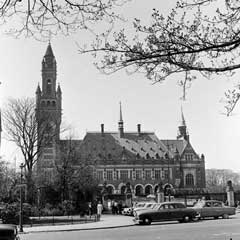
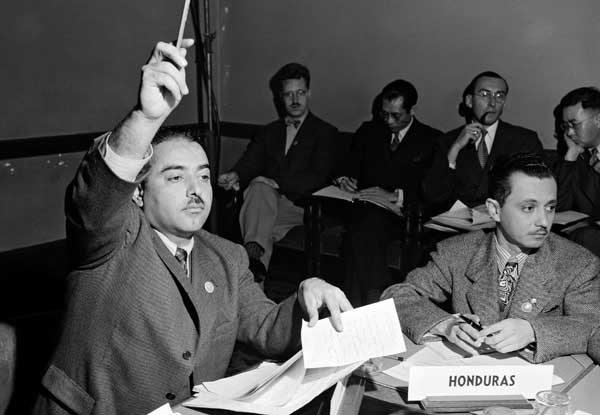
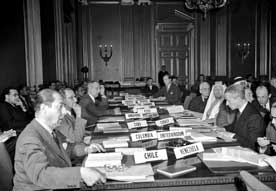 The ICJ Statute (like previously that of the PCIJ) lists, in Article 38, the “formal” sources of international law.
The ICJ Statute (like previously that of the PCIJ) lists, in Article 38, the “formal” sources of international law.